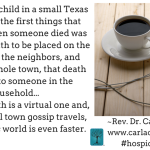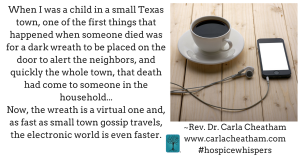
A couple of years ago, blogger Bobbie Johnson posted a poignant piece called “#Grieving” that looked at our need to turn to social media to share our grief and reach out for support.
With recent national and international tragedies, we are seeing the value and challenges that instantaneous notifications can provide us individually and collectively.
Johnson’s piece is still very relevant as we consider why and how we integrate our culture of grieving into our culture of electronic connection.
We’ve learned in hospice to warn families to be clear about their communication plan for notifying others when a loved one dies, because of the potential for innocent and natural on-line behavior, poorly-timed, to cause problems for all involved.
When I was a child in a small Texas town, one of the first things that happened when someone died was for a dark wreath to be placed on the door to alert the neighbors, and quickly the whole town, that death had come to someone in the household.
It was the cue to come pay respects, bring chicken spaghetti casseroles and green jello molds with pineapple, hugs and stories, and to make a plan for who was going to mow the field and tend the cows and rake the leaves in the yard in the coming season since he was not there to do so, anymore.
Now, the wreath is a virtual one and, as fast as small town gossip travels, the electronic world is even faster. And in another case of “Let’s not let technology outgrow our wisdom to manage it healthily”, we need to pay attention to and navigate the potential pitfalls, while also enjoying the benefits of instant support.
Take this scenario, for example:
Dad was dying. Two adult children and their spouses were there. The last son and daughter in law were on the road, driving in from out of town. When they were only about 20 minutes away, dad died.
The family decided they felt safer waiting to tell them until they arrived rather than have them upset while driving down the last stretch of road.
Those family members present naturally called their young adult children to let them know the news, as they waited for their brother and sister-in-law to arrive.
In the remaining 10 minutes that it took for them to get there, after frantically driving for hours to try to make it in time, the two sets of grandchildren who now knew about granddad’s death did what they knew to do–they posted their grief on Facebook.
Daughter in law, in the passenger’s seat, was browsing Facebook to pass the anxiety-producing time as they tried to hurry up and get to Dad’s bedside.
You see where this is going…
Daughter in law to son, “Honey?
Son, “Yeah, babe?”
Daughter in law, “Your dad just died!”
We can only imagine how hard it was for them to know that thousands of strangers knew their father and father in law had died before they did…
THAT was a tough situation. Cognitively, they understood it was an accident. They tried to be gracious, but it added definite insult to the injury of grief and not being there in time, and it took a lot of conversation and even more time for that to heal.
So the conversation about how we grieve via social media, what it means to us, what “etiquette” to consider, etc. is definitely important and even necessary!
It’s not inherently a “bad” thing to share in this new way. It’s the modern day version of showing up for each other and sharing our grief. We just need to be mindful to use it in a way that is loving to all.
Here are 3 things to consider:
- Ask family members ahead of time how and when they want to be notified–while driving, in the middle of the night, etc?
- Decide who will tell whom, and make certain no one announces the information through social media until the list of “first to know” have been notified.
- Talk about who wants to TRY to be there when your loved one dies, but make certain everyone remembers that sometimes things happen unexpectedly and sometimes the person chooses a moment when not everyone is there. It’s not personal and not a slight. People pick the moment that works best for them and, sometimes, try to “protect” their family from being there when they die. Be ready for anything without guilt or resentment.
In time, we will have developed a whole new culture around how to handle such moments thoughtfully and carefully. Until then, as we fumble through, let’s be especially mindful and intentional about how we handle those moments, so that everyone may get the support they need during a difficult and already heartbreaking time.
Peace,
Carla
 About Rev. Dr. Carla Cheatham:
About Rev. Dr. Carla Cheatham:
After a career in social services and advanced degrees in Psychology, Health Education, and Divinity, Carla began working in hospice. She trains healthcare staff on a multitude of topics through her own Carla Cheatham Consulting Group, LLC and is the author of Hospice Whispers: Stories of Life, available in paperback and as an e-book through Amazon and also as an audiobook through Audible. A companion volume, Sharing Our Stories: A Hospice Whispers Grief Support Workbook based on those stories is set to publish August 2016. Follow Carla’s writings through her website blog and also on Facebook or on Twitter @CarlaCheatham.


